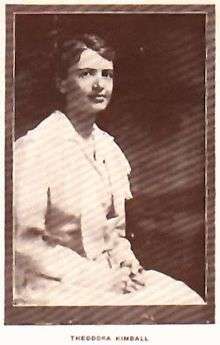Theodora Kimball Hubbard

Theodora Kimball Hubbard (1887-1935) was the first librarian of the Harvard School of Landscape Architecture, and a contemporary of and collaborator with many significant figures in landscape architecture in expanding the body of knowledge in that subject area.
Education and career
Theodora Kimball Hubbard was a graduate of Simmons College, and worked as the Landscape Architecture Librarian at Harvard from 1911-1924. She left Harvard in 1924, the year she married Henry Vincent Hubbard, but continued to serve the library in an advisory capacity. She served on President Herbert Hoover's advisory Committee on Zoning in Washington, D.C. as an expert on zoning, and also a member of the research committee for the President's Conference on Home Building and Home Ownership. She is credited with writing over 100 editorials, articles, and reviews in addition to preparing detailed bibliographies and reports on the fields of landscape and city planning. She collaborated with her husband on a basic textbook for landscape architecture, An Introduction to the Study of Landscape Design, which for many years was considered the standard text. Through her work she achieved international recognition.
In 1919, Hubbard became the first woman accepted as a member to the American City Planning Institute. That same year she developed the first Library of Congress Classification for landscape architecture under the subclass (NAB). She developed a separate classification scheme for city planning under the subclass (NAC). She was assisted in this endeavor by her husband Henry Vincent Hubbard (1875-1945), a Harvard professor, and the founding editor of Landscape Architecture Magazine. Renowned landscape architect, Frederick Law Olmsted, the designer of a network of parks known as the "Emerald Necklace" in Boston, Central Park in New York, and idyllic greenspaces across the United States is given special acknowledgment in the preface of the published classification scheme, for having contributed many constructive suggestions. The Library of Congress originally assigned a place for landscape architecture as a sub-classification to architecture (NA) by the addition of the letter (B). The authors thought that this placement most precisely acknowledged the artistic component of landscape architecture, whereas placing it in subclass (S), as it is today, would suggest that it is simply another form of agriculture. Books acquired in this subject area since 1978 are now classed in (SB).
One of her most important works: "Municipal Accomplishment in City Planning" a bibliography of all of the works on urbanism in the United States was published in Europe and the United States to great acclaim. As a librarian and writer she made great contributions to the advancement of the profession of landscape design by organizing the information, critiquing the work, and contributing to the literature, giving the field more substance, status and visibility in academic circles.
Selected bibliography
- Hubbard, Henry Vincent; Hubbard, Theodora Kimball (1917). An introduction to the study of landscape design. New York: The Macmillan Company.
- Pray, James Sturgis; Hubbard, Theodora Kimball (1913). City planning; a comprehensive analysis of the subject arranged for the classification of books, plans, photographs, notes and other collected material, with alphabetic subject index. Cambridge: Harvard University Press.
- Hubbard, Henry Vincent; Hubbard, Theodora Kimball (1920). Landscape architecture ; a comprehensive classification scheme for books, plans, photographs, notes and other collected material, with combined alphabetic topic index and list of subject headings. Cambridge: Harvard University Press.
- Hubbard, Theodora Kimball (1920). Municipal accomplishment in city planning and published city plan reports in the United States. Boston: National Conference on City Planning.
References
- Sammarco, Anthony (2002-11-07). "A Piece of Our History: The Magnificent Kimball Siblings were nationally respected". Milton Times.
- "Theodora Kimball Hubbard: A Biographical Minute.". Landscape Architecture. 26 (2): 53–55. January 1936.
- "Theodora Kimball Hubbard". Planners Journal. 1 (4): 95. 1935. doi:10.1080/01944363508978656.
- "El Urbanismo en los Estados Unidos: Theodora Kimball". Revista Municipal y de Intereses Economicos. 16 (9). April 1921.